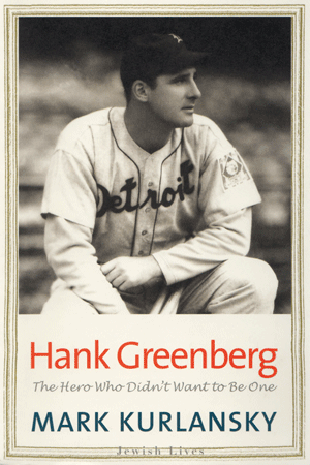Reviewed by NEAL GENDLER
Hank Greenberg became one of baseball’s legendary hitters, but his near-instant fame came from something he didn’t do: He didn’t play a game of the 1934 World Series that fell on Yom Kippur.
That decision, made in Greenberg’s second big slugging season — when he would hit .339 — made him a hero to many American Jews. Yet Greenberg, raised in a loving Orthodox household, was almost totally non-observant.
“Greenberg never wanted to be known as the Jewish baseball player,” nor was he the first, says Hank Greenberg author Mark Kurlansky. “But it was his lot to play baseball in the most anti-Semitic period in American history…. Whether he liked it or not, Greenberg was never going to be just a baseball player.”
As a player and later a general manager, Greenberg “spent the better part of 20 years on the receiving end of anti-Semitic abuse in ballparks.” But he became an inspiration, his mystique rooted in his “unconscious ability to rewrite the Jewish stereotype.”

Greenberg’s demeanor was an example for Jackie Robinson, whom Kurlansky called “even more abused.” Greenberg said Robinson had it “tougher than any baseball player who ever lived,” and told him during an encounter at first base to “stick in there. You’re doing fine. Keep your chin up.”
As did Hyman Greenberg, who became Hank in the 1930s, then Henry. Life might have been easier as Green or Berg; but “Greenberg never tried to conceal his ethnic identity,” writes Kurlansky. And “privately, Greenberg was both embarrassed and amused by his new image” as a “mythic super-Jew.”
Baseball statistics are in the back bleachers in this rather adoring biography, which focuses on Greenberg as uncomfortable with adulation and as a Jew in a Gentile, bigot-ridden occupation. Only when managing the Cleveland Indians for good friend Bill Veeck was Greenberg “somewhat volatile,” not getting along well with owners or players, “in sharp contrast to his popularity as a player.”
Veeck, a lifelong friend, was “a man of high principles, like Greenberg, but also of crass showmanship,” Kurlansky says. “Veeck insisted that even a losing team could draw fans and make money if management made the ballpark experience fun.”
(The lesson was learned by his son, Mike, a St. Paul Saints owner whose games have included a nun in the stands giving massages, a pig delivering balls to the umpire and giveaways of inflatable bats labeled Viagra.)
Although he hit 58 home runs in 1938, Greenberg said that what mattered more was hitting game-winning singles and doubles. He batted better than .300 for eight years in a row: 1933-1941. (He sat out 1936 after breaking his wrist in an April game.)
Kurlansky says Greenberg was not a naturally talented ballplayer. He wasn’t a great fielder — although, at 6 foot 4, he had a long first baseman’s reach — and on flat feet he didn’t run very well. Instead, he was very hardworking, starting even in high school to perfect his swing, which Kurlansky calls “one of the most beautiful sights in the history of baseball.”
Greenberg was a talented negotiator, however. His 1939 contract was $40,000, making him the second-highest paid player to date after Babe Ruth. He managed his money well, even as “expensive and elegant clothing was to become a Greenberg trademark.” Yet “style didn’t equal extravagance,” and he retired from baseball well off.
Drafted into the Army in 1941, he became a lieutenant who inspected air bases. He returned in time to play in the 1945 season, but never quite regained his full skills. And baseball no longer was all-consuming for a more worldly man who married into the sophisticated — and even more nonobservant — Gimbel department store family. He turned to art and books and, post-baseball, tennis.
Although brief, the book builds a strong impression of Greenberg’s character. The only error I saw was likely a typo: December 1945 instead of 1943 for the combat death of former Red Sox outfielder Si Rosenthal’s son. I would have liked more than two photos.
Greenberg learned that he had kidney cancer in 1984 and withdrew, not wanting to be seen until he was well. He died in his sleep in 1986 at 75.
A younger tennis pal, Rabbi Leonard Bierman, said that among Jewish athletes, “no one stood out like Hank Greenberg.” In his time, “he was the only example of Jewish muscular strength.”
***
Hank Greenberg and other great Jewish athletes will be honored by the St. Paul Saints on June 12 — Jewish Community Day at Midway Stadium.
Neal Gendler is a Minneapolis writer and editor.
(American Jewish World, 5.27.11)




















Comments 1